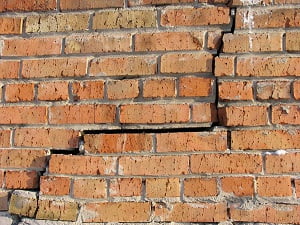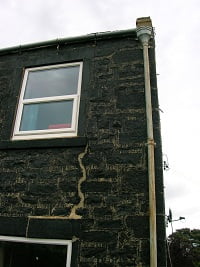A Guide to Structural Repair and Maintenance
Unwanted structural movement in buildings can cause a good deal of distress and worry for homeowners. Subsidence, physical disturbance and a failure of building materials are just some of the factors that can impact on the structural integrity of a property. Fortunately, while there are many reasons why a building can move, modern repair technology and advances in application techniques mean that effective solutions are on hand to tackle the problem.
This guide gives an overview of some of the most common problems householders face, describes some of the repair strategies available – and outlines the importance of seeking expert advice for individual projects.
Buildings On The Move
Buildings can move for a variety of reasons, including;
- Ground movement or subsidence
- Inadequately restrained or tied walls
- Movement brought on by water ingress and timber decay into the structure
- Failed lintels or building materials
- Movement fatigue
- Mechanical impact or disturbance

Surprisingly, despite the unusual climate the UK has seen in recent years – moving seamlessly between flood, drought and extremes of temperature – the weather is not the most common cause of problems to a building’s structure. In extreme dry weather, problems can arise as soil shrinks due to a lack of water, which can ultimately lead to cracks appearing in buildings. This is because, as the soil that sits around and below the walls and floors of a home becomes dryer, it can shrink.
In certain circumstances this can result in instability in the walls, causing movement that shows itself as cracks in the fabric of the affected building. However, in most cases, while the cracking associated with drought conditions can be unsightly and distressing but is often of little structural significance and may even close back up after rainfall.
Heavy rainfall can also take its toll, but this is generally a matter of regular building maintenance rather than extremes of weather. For example, allowing water to seep into a home through broken roof tiles or poorly applied flashing on chimneys, can mean water enters a property over a long period of time, creating conditions for timber to decay and eventually collapse.
The Repair Process
We would advise a householder to contact their household insurer if cracks develop in a property. They are likely to appoint a specialist structural surveyor to monitor the situation before any works are deemed necessary. This surveillance can take a while, but the right diagnosis is always worth waiting for. If structural repairs are eventually needed the good news is these can now be undertaken with far less disruption than was commonplace in the past.
In short, structural repair and stabilisation offers a cost effective, low impact and environmentally sound alternative to demolition and rebuilding – and is vital to preserve and protect buildings in the UK. However, protecting the building and achieving a successful remedy to structural instability whilst carrying out structural repairs, presents a number of challenges. It is essential therefore, that contractors with the necessary competencies and experience are selected for the long term success of any structural repair programme.

First and foremost, with any problem associated with a structural defect, it is vital that a professional inspection is carried out to build an accurate picture of the issue to be faced. This will often involve a structural engineer who can work closely with the contractor to deliver the appropriate repair.
Nothing should be left to chance, and time and finances need to be set aside to ensure any problems are correctly identified and an accurate diagnostic inspection should be the basis for the repair strategy.
Once the cause of any problem is established, a solution then needs to be drawn up. This must consider many aspects, including the building’s use, the implied loads, the materials used in the building and the form and feasibility of any rectification work. It is absolutely critical that a structural engineer is involved to supervise and draw up the specification and works in partnership with the appointed contractor.
Repair Techniques
There are a number of methods available to deal with the various types of structural repair. For example, cavity wall tie corrosion, a common problem in cavity walled properties, has reasonably simple and well-established remediation strategies. New stainless steel ties can be installed, either fixed into the walls using resins or mechanically. The defective or corroded ties can be isolated or removed when necessary but, in some specific situations, can even be left in-situ.
One problem we can come across is cracking as a result of movement in the ground supporting the walls and floors. This movement in a building’s structure is commonly referred to as subsidence, and again there are a number of ways that the cracks and bulges occurring in the wall as a result of ground movement can be repaired.
Subsidence can be caused by trees removing water from the soil or heave or up-lift, caused by root growth, shifting water tables, drought, corrosion, decay, poor workmanship or lack of maintenance, erosion, vibration and even salt attack.
Foundation problems and the movement of walls are all commonplace where ground subsidence occurs. Before dealing with the cracks and bulges caused by ground movement it is important to fully understand, and in most cases halt the movement, and stabilise the foundations. Traditionally this was done through underpinning – a long and costly process that often required large scale excavations to introduce large volumes of new concrete below the existing foundations.
In recent years ground stabilisation using materials injected into the ground and remedial ground piles have offered a “lower impact” solution. It is important however to ensure that whatever technique is adopted that this is conducted by trained and competent ground workers – preferably members of ASUCplus. Once the foundations are stabilised it may be necessary to restore the structural and mechanical bonds that were broken when the cracks formed. This is also the case where buildings have cracked or become unstable as result of impact damage, lateral movement, water ingress, poor building practice, thermal expansion and wind loading. Methods used to resolve such problems include pinning, strapping, piling, lateral restraint systems and steel reinforced cementitious anchors.
Crack stitching using profiled stainless steel bars, resin grout and other innovative products and materials, is now widely accepted as an effective method of repair. These systems are highly effective in dealing with a huge range of situations where repair, reinforcement, stabilisation or when improvements are needed to the structural strength of stone, concrete and brick structures. Lintel replacement and panel strengthening can also be undertaken, often saving huge sums that would otherwise have been spent on demolition and rebuilding. In many situations invasive rebuilding and the disturbance of historic structures can be minimised with the repaired building often showing little evidence of any intervention to correct structural problems.
It is also possible to repair, strengthen and improve structural timbers using resin repair and reinforcement techniques, which have been developed and mastered by PCA members. The structural repair of important and often irreplaceable wooden structures offers an effective and highly reliable means of repairing and retaining beams, joists, lintels and other timber elements. Advanced technology, techniques and expertise were once the preserve of historical buildings, but now these methods are finding a place in the restoration and preservation of more modern domestic properties. With the knowledge and skills available in this field, it now makes sense to repair rather than replace in many situations.
The PCA – Representing Experts in Structural Repair
Members of the Property Care Association (PCA) that specialise in structural repair should be the first port of call for practical advice on structural maintenance.
Representing the nation’s structural maintenance industry, as well as the structural waterproofing, wood preservation and flood remediation sectors, the trade body brings together training, high levels of technical expertise and professional surveyor, manufacturer and contractor members.
As well as delivering trusted structural maintenance and stabilisation services, PCA members are also able to carry out specialist surveys – to identify potential problems – together with a range of other services and expertise ultimately designed to preserve and protect buildings across the UK. In addition, many of the PCA’s members have extensive experience of working within the historic building sector and understand the concerns and special requirements needed within these areas, including the use of non-intrusive technology.
The Association’s members have also worked on the development and use of pioneering structural maintenance and stabilisation techniques, including methods of application that work sympathetically with existing buildings. Tapping into the expertise of a PCA member gives access to these innovative, flexible solutions – available for a wide range of structural repair challenges.
The PCA’s nationwide list of contractor members are all carefully vetted before being awarded membership – and are then subject to rigorous auditing procedures once admitted to the trade body. Members of the trade body can offer insured guarantees for much of the structural work they undertake.
The PCA also offers a range of training and technical support to help property professionals tackle problems associated with structural maintenance. Courses are provided in a number of subjects including timber resin repair and cavity wall tie repair.
Find a Qualified Structural Repair Specialist
View Training Courses